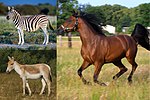Oligocene. Like many fossil horses, Mesohippus was common in North America. Its shoulder height is estimated at 60 cm. Mesohippus had longer legs than its predecessor...
4 KB (348 words) - 05:52, 5 July 2024
Evolution of the horse (section Mesohippus)
from the main genus Mesohippus, coexisted with Mesohippus for around four million years, and then over time came to replace Mesohippus. Miohippus was significantly...
58 KB (6,775 words) - 07:39, 21 May 2024
†Desmatippus Genus †Hypohippus Genus †Kalobatippus Genus †Megahippus Genus †Mesohippus Genus †Miohippus Genus †Parahippus Genus †Sinohippus Subfamily Equinae...
16 KB (1,437 words) - 02:16, 4 September 2024
natural association between his horses and the dogs that accompanied them. Mesohippus Protohippus Wikispecies has information related to eohippus. Wikimedia...
5 KB (452 words) - 19:12, 13 July 2024
back foot. The extra toe on the front feet soon disappeared with the Mesohippus, which lived 32 to 37 million years ago. Over time, the extra side toes...
141 KB (15,033 words) - 14:03, 17 September 2024
were within the margin of 25 to 30 kg. Miohippus became much larger than Mesohippus. They weighed around 40 to 55 kilograms. They were somewhat larger than...
7 KB (628 words) - 11:12, 12 June 2024
than the living members of the family. The group first appeared with Mesohippus in North America during the middle Eocene and thrived until the late Miocene...
3 KB (166 words) - 21:33, 21 August 2024
had soft pads. Equids developed into larger, three-toed animals (e.g. Mesohippus) during the Oligocene and Miocene. From there, the side toes became progressively...
54 KB (5,606 words) - 11:33, 3 September 2024
million years ago North America: Archaeotherium, Hyaenodon, Dinictis, Mesohippus, Poebrotherium, Subhyracodon, Moropus, Merycoidodon, Daeodon, Amphicyon...
6 KB (231 words) - 04:20, 10 July 2024
as Poebrotherium), running rhinoceratoids, three-toed equids (such as Mesohippus), nimravids, protoceratids, and early canids like Hesperocyon. Merycoidodonts...
71 KB (7,912 words) - 12:41, 17 September 2024









